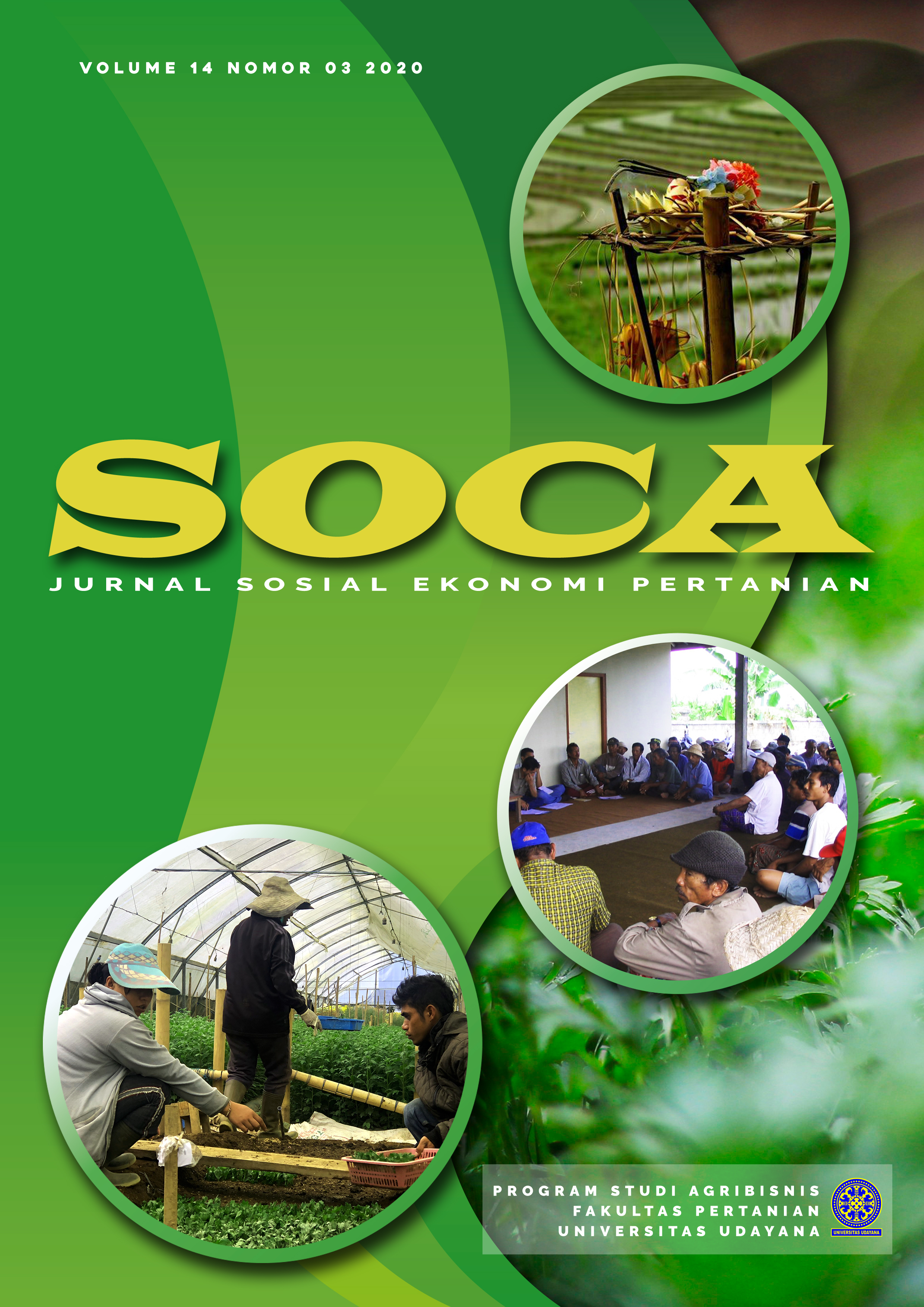The Analysis of Technical Efficiency of Inbred and Hybrid Lowland Rice Farming Business
Abstract
The background of this research was the unachieved rice productivity of hybrid lowland rice which targeted by the Director General of Crops in 2017. Hybrid lowland rice farmers were assumed did not reach the full efficiency in the use of production factors. This study aimed to explain the general description of inbred and hybrid lowland rice farming business; analyzed the factors that influence the level of business production, and analyzed the technical efficiency and the factors that influence the technical inefficiencies of the farming business. These aims can be answered by the Stochastic Frontier Analysis (SFA) method. The data used was the raw data of the Crops Cost Structure Survey 2017 in East Java Province. This province was chosen because it was the largest production contributor of rice field in Indonesia. Harvesting area, seeds and fertilizers gave a good effect to both for inbred and hybrid lowland rice production, and for hybrid rice production were also supported by labor. The technical efficiency of inbred lowland rice production was higher (81.17 percent) compared to hybrid lowland rice production (70.49 percent). The factors that affected the technical inefficiency of inbred lowland rice were gender, education, pest control, tractors usage, counseling, and the number of labor, while factors that affected to technical inefficiency of hybrid lowland rice, education, pest control, and tractors usage.
Downloads
References
Badan Pusat Statistik Jawa Timur. (2018). Luas Panen, Produktivitas, dan Produksi Komoditi Padi Sawah di Jawa Timur, 2002-2017. Badan Pusat Statistik.
Direktorat Jenderal Tanaman Pangan. (2015). Rencana Strategis Direktorat Jenderal Tanaman Pangan Tahun 2015-2019. Kementerian Pertanian: Direktorat Jenderal Tanaman Pangan.
Direktorat Jenderal Tanaman Pangan. (2016). Pedoman Pelaksanaan Kegiatan 2017. Kementerian Pertanian: Dirjen Tanaman Pangan.
Irawan, B. (2004). Dinamika Produktivitas dan Kualitas Budidaya Padi Sawah. In Ekonomi Padi Dan Beras Indonesia (pp. 179–199). Badan Penelitian dan Pengembangan Pertanian.
Junaedi, M. (2016). Efisiensi dan Kesenjangan Teknologi Usahatani Padi Sawah di Indonesia. [Disertasi]. Bogor: Universitas Pertanian Bogor.
Kasturi, B. A. (2012). Analisis Faktor-faktor Yang Mempengaruhi Produksi Padi di Kabupaten Wajo. [Skripsi]. Makassar: Universitas Hasanuddin Makassar.
Peraturan Menteri Pertanian, Pub. L. No. 23/Permentan/SR.120/2/2007 tentang Pedoman Umum Peningkatan Produktivitas dan Produksi Padi, Jagung dan Kedelai Melalui Bantuan Benih (2007).
Peraturan Menteri Pertanian, Pub. L. No. 40/Permentan/OT.140/4/2007 tentang Rekomendasi Pemupukan N, P, dan K pada Padi Sawah Spesifik Lokasi (2007).
Kementerian Pertanian. (2018). Swasembada Pangan Suatu Keharusan. Kementerian Pertanian RI. https://www.pertanian.go.id/home/?show=news&act=view&id=2496
Kompas. (2017, July). Petani Sebaiknya Ganti Varietas Padi. https://kompas.id/baca/ekonomi/2017/07/03/petani-sebaiknya-ganti-varietas-padi/
Krishnamurti, I., & Biru, M. D. (2019). Prospek dan Tantangan Padi Hibrida di Indonesia. Center for Indonesia Policy Studies. www.cips-indonesia.org
Kusnadi, N., Tinaprilla, N., Susilowati, S. H., & Purwoto, A. (2011). Analisis Efisiensi Usaha Tani Padi di Beberapa Sentra Produksi Padi di Indonesia. Jurnal Agro Ekonomi, Vol. 29 No, 25–48. http://ejurnal.litbang.pertanian.go.id/index.php/jae/article/view/4041/3370
Nwaru, J. C., Okoye, B. C., & Ndukwu, P. C. (2011). Measurement and Determinants of Production Efficiency among Small-Holder Sweet Potato (Ipomoea Batatas) Farmers in Imo State, Nigeria. European Journal of Scientific Research, Vol. 59(3), 307–317. https://www.researchgate.net/publication/286721101_Measurement_and_determinants_of_production_efficiency_among_small-holder_sweet_potato_ipomoea_batatas_farmers_in_Imo_State_Nigeria
Rivanda, D. R., Nahraeni, W., & Yusdiarti, A. (2015). Analisi Efisiensi Teknis Usahatani Padi Sawah (Pendekatan Stochastic Frontier). Jurnal AgribiSains, Vol. 1 No., 1–13. https://ojs.unida.ac.id/AGB/article/view/140
Suharyanto, Mulyo, J. H., Darwanto, D. H., & Widodo, S. (2015). Analisis Produksi dan Efisiensi Pengelolaan Tanaman Terpadu Padi Sawah di Provinsi Bali. Jurnal Penelitian Pertanian Tanaman Pangan, Vol. 34(2), 131–143. https://doi.org/10.21082/jpptp.v34n2.2015.p131-143
Tinaprilla, N. (2012). Efisiensi Usahatani Padi Antar Wilayah Sentra Produksi di Indonesia: Pendekatan Stochastic Metafrontier Production Function. [Disertasi]. Bogor: Universitas Pertanian Bogor.













